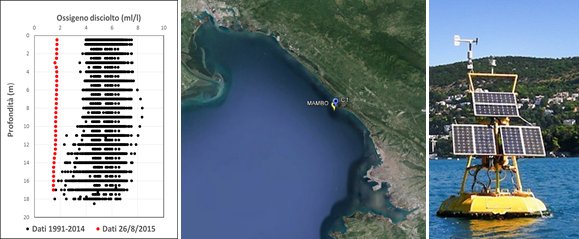31 August, An exceptional decrease in dissolved oxygen in the waters of the Gulf of Trieste
Last Wednesday (26/8/2015), the waters of the Gulf of Trieste were extremely poor in dissolved oxygen. Data collected by OGS researchers revealed an exceptionally low concentration of dissolved oxygen along the whole water column and, in particular, in the surface layer where dissolved oxygen concentration is in balance with overlying air concentration. Oxygen, the gas which allows life on Earth and in the Oceans, is produced by plant organisms due to photosynthesis. It is soluble in seawater and is particularly abundant in the surface layer thanks to contact with atmosphere, rich in oxygen. What happened then last Wednesday in the waters of the Gulf of Trieste?
The regular monitoring in the long term ecological research site (LTER) located at the outer limit of the Marine Protected Area of Miramare allowed to recognise an exceptional lack of oxygen, which has never been observed previously, during 25 years of monthly monitoring (Fig. 1 - Dissolved oxygen concentration (ml/l) measured along the water column in C1-LTER on Wednesday 26/8/2015 (red dots) and monthly data collected in the years 1991 – 2014 (black dots) (left). Position of the monitoring sites LTER and MAMBO (centre) and meteo – oceanographic buoy MAMBO (right)).
Thanks to availability of continuous data collected by the meteo – oceanographic buoy MAMBO of OGS, located close to C1-LTER site, we can understand the dynamic of this exceptional event, brought about by the Bora wind. The sudden and moderately intense wind outburst has, in fact, mixed the whole water column, bringing deeper waters, colder and saltier, but, most of all, oxygen depleted, to the surface layer (Fig. 2 - Time series of wind speed (m/s), dissolved oxygen concentration (ml/l), water temperature (°C) and salinity (psu) measured in the time-frame 21/8/2015 – 27/8/2015 by the meteo – oceanographic buoy MAMBO).
Oxygen depletion in the bottom waters can determine hypoxia (low oxygen concentration) and, in extreme conditions, to anoxia (lack of oxygen). These are very serious events which threaten organisms living on the bottom and within the sediment (fish, mollusks, crustaceans, sponges,…).
It is extremely difficult to observe hypoxia in the surface layer, with concentrations a slow as those observed last Wednesday.
Extreme meteo – marine events, which are more frequent in the recent decades, determine anomalous situations whose effects on the ecosystem are still to be explored.
In this framework, availability of real time data (MAMBO buoy), together with data collected in long time series (LTER site) allow to trace anomalies and investigate their effects.


